Research Optimizing Building Ventilation Performance through the Application of Trombe Walls in Regions with Hot Summers and Cold Winters: A Case Study in China
Abstract
:1. Introduction
2. Research Method
2.1. Study Areas
2.2. Research Subject
2.3. Air Movement Equation
2.4. Physical Models for Numerical Simulation
2.5. Numerical Simulation Meshing
2.6. Boundary Condition Settings for Numerical Simulation
3. Experimental Measurement
3.1. Measuring Point Layout
3.2. Experimental Setup
3.3. Experimental Details
3.4. Verification Results
3.5. Analysis of Calculation Errors
4. Analysis of Experimental and Simulated Results
4.1. Trends in Solar Radiation Variability
4.2. Comparison of Wind Speed Contours for Each Month
4.3. Variations in Wind Speed at Different Time
4.4. Comparison of Psychrometric Charts
5. Conclusions
- (1)
- With an in-depth exploration of the Trombe wall’s ventilation performance across various seasons, it is concluded that the Trombe wall performs well in spring, autumn, and transitional seasons, achieving an average wind speed increase of 0.2 m/s to 0.8 m/s in the central part of the building and 0.9 m/s to 3.6 m/s at the inlet of the Trombe wall. However, its performance in summer is suboptimal, with extensive areas of still air inside the building, failing to effectively improve the indoor wind environment. Therefore, the Trombe wall in hot-summer and cold-winter regions should be utilized during spring, autumn, and transitional seasons.
- (2)
- Due to the thermal storage properties of the Trombe wall, its ventilation effectiveness is relatively weaker in the morning hours, exhibiting a steady increase from 9 a.m. to 12 p.m. The wall temperature peaks at noon, resulting in a significant improvement in ventilation effectiveness, which remains high until 3 p.m. Observing the Trombe wall’s daytime operation, the wall temperature maintains a high level from noon until evening, thereby ensuring effective ventilation and pronounced thermal convection.
- (3)
- Incorporating wind speed data into psychrometric charts and thermal comfort models reveal that May and September experience a higher proportion of indoor thermal comfort, accounting for 47% and 45%, respectively, which further indicates that following the application of the Trombe wall, there is a significant improvement in indoor thermal comfort during transitional seasons while maintaining the stability of the indoor wind environment.
Author Contributions
Funding
Institutional Review Board Statement
Informed Consent Statement
Data Availability Statement
Acknowledgments
Conflicts of Interest
References
- GBJ96-86; Code for Design of Residential Buildings—Code Forresidential Building Design. Ministry of Environmental Protection of the People’s Republic of China: Beijing, China, 1987.
- Lee, K.H.; Strand, R.K. Enhancement of natural ventilation in buildings using a thermal chimney. Energy Build. 2009, 41, 615–621. [Google Scholar] [CrossRef]
- Zhai, X.; Song, Z.; Wang, R. A review for the applications of solar chimneys in buildings. Renew. Sustain. Energy Rev. 2011, 15, 3757–3767. [Google Scholar] [CrossRef]
- Shi, L.; Zhang, G.; Cheng, X.; Guo, Y.; Wang, J.; Chew, M.Y.L. Developing an empirical model for roof solar chimney based on experimental data from various test rigs. Build. Environ. 2016, 110, 115–128. [Google Scholar] [CrossRef]
- Haaf, W.; Friedrich, K.; Mayr, G.; Schlaich, J. Solar chimneys part I: Principle and construction of the pilot plant in Manzanares. Int. J. Sol. Energy 1983, 2, 3–20. [Google Scholar] [CrossRef]
- Fordham, M. Natural ventilation. Renew. Energy 2000, 19, 17–37. [Google Scholar] [CrossRef]
- Khedari, J.; Rachapradit, N.; Hirunlabh, J. Field study of performance of solar chimney with air-conditioned building. Energy 2003, 28, 1099–1114. [Google Scholar] [CrossRef]
- Shi, L.; Zhang, G.; Yang, W.; Huang, D.; Cheng, X.; Setunge, S. Determining the influencing factors on the performance of solar chimney in buildings. Renew. Sustain. Energy Rev. 2018, 88, 223–238. [Google Scholar] [CrossRef]
- Fahmy, M.; Mahdy, M.M.; Nikolopoulou, M. Prediction of future energy consumption reduction using GRC envelope optimization for residential buildings in Egypt. Energy Build. 2014, 70, 186–193. [Google Scholar] [CrossRef]
- Abdeen, A.; Serageldin, A.A.; Ibrahim, M.G.; El-Zafarany, A.; Ookawara, S.; Murata, R. Solar chimney optimization for enhancing thermal comfort in Egypt: An experimental and numerical study. Sol. Energy 2019, 180, 524–536. [Google Scholar] [CrossRef]
- Elghamry, R.; Hassan, H. Impact a combination of geothermal and solar energy systems on building ventilation, heating and output power: Experimental study. Renew. Energy 2020, 152, 1403–1413. [Google Scholar] [CrossRef]
- Sá, A.B.; Boaventura-Cunha, J.; Lanzinha, J.C.; Paiva, A. An experimental analysis of the Trombe wall temperature fluctuations for high range climate conditions: Influence of ventilation openings and shading devices. Energy Build. 2017, 138, 546–558. [Google Scholar]
- Jiru, T.E.; Bitsuamlak, G.T. Application of CFD in modelling wind-induced natural ventilation of buildings-A review. Int. J. Vent. 2010, 9, 131–147. [Google Scholar] [CrossRef]
- Khanal, R.; Lei, C. Flow reversal effects on buoyancy induced air flow in a solar chimney. Sol. Energy 2012, 86, 2783–2794. [Google Scholar] [CrossRef]
- Du, L.; Ping, L.; Yongming, C. Study and analysis of air flow characteristics in Trombe wall. Renew. Energy 2020, 162, 234–241. [Google Scholar] [CrossRef]
- Jiménez-Xamán, C.; Xamán, J.; Gijón-Rivera, M.; Zavala-Guillén, I.; Noh-Pat, F.; Simá, E. Assessing the thermal performance of a rooftop solar chimney attached to a single room. J. Build. Eng. 2020, 31, 101380. [Google Scholar] [CrossRef]
- Sundar, S.; Prakash, D.; Surya, V. Analysis and Optimization of Passive Wall Solar Chimney through Taguchi’s Technique. Appl. Sol. Energy 2020, 56, 397–403. [Google Scholar] [CrossRef]
- Bilgen, E. Conjugate heat transfer by conduction and natural convection on a heated vertical wall. Appl. Therm. Eng. 2009, 29, 334–339. [Google Scholar] [CrossRef]
- Long, J.; Yongga, A.; Sun, H. Thermal insulation performance of a Trombe wall combined with collector and reflection layer in hot summer and cold winter zone. Energy Build. 2018, 171, 144–154. [Google Scholar] [CrossRef]
- Ma, Q.; Fukuda, H.; Lee, M.; Kobatake, T.; Kuma, Y.; Ozaki, A. Study on the utilization of heat in the mechanically ventilated Trombe wall in a house with a central air conditioning and air circulation system. Appl. Energy 2018, 222, 861–871. [Google Scholar] [CrossRef]
- Koronakis, P. Solar chimney dynamic performance under typical Mediterranean summer conditions. Int. J. Sol. Energy 1992, 13, 73–84. [Google Scholar] [CrossRef]
- Demirbilek, F.N.; Yalçiner, U.G.; Ecevit, A.; Sahmali, E.; Inanici, M. Analysis of the thermal performance of a building design located at 2465m: Antalya-Saklikent National Observatory guesthouse. Build. Environ. 2003, 38, 177–184. [Google Scholar] [CrossRef]
- Zhou, Y.; Wang, Z.; Xu, L.; Zhang, S.K.; Sui, C.J. Characteristic analysis of buoyancy induced indoor ventilation in Trombe wall channels. Acta Energiae Solaris Sin. 2021, 42, 8. [Google Scholar]
- ANSYS Inc. ANSYS FLUENT Theory Guide; ANSYS Inc.: Canonsburg, PA, USA, 2013. [Google Scholar]
- Gowda, B.K.; Rajagopal, M.; Seetharamu, K. Heat transfer in a side heated trapezoidal cavity with openings. Eng. Sci. Technol. Int. J. 2019, 22, 153–167. [Google Scholar] [CrossRef]
- JGJ/T 449-2018; Calculation Standard for Green Performance of Civil Buildings. Ministry of Housing and Urban Rural Development of the People’s Republic of China, China Architecture & Building Press: Beijing, China, 2018.
- Franke, J.; Hellsten, A.; Schlünzen, H.; Carissimo, B. Best Practice Guideline for the CFD Simulation of Flows in the Urban Environment. COST European Cooperation in Science and Technology; COST Office: Brussels, Belgium, 2007. [Google Scholar]
- Tominaga, Y.; Mochida, A.; Yoshie, R.; Kataoka, H.; Nozu, T.; Yoshikawa, M.; Shirasawa, T. AIJ guidelines for practical applications of CFD to pedestrian wind environment around buildings. J. Wind Eng. Ind. Aerodyn. 2008, 96, 1749–1761. [Google Scholar] [CrossRef]
- Chantawong, P.; Hirunlabh, J.; Zeghmati, B.; Khedari, J.; Teekasap, S.; Win, M.M. Investigation on thermal performance of glazed solar chimney walls. Sol. Energy 2006, 80, 288–297. [Google Scholar] [CrossRef]
- Shen, J.; Lassue, S.; Zalewski, L.; Huang, D. Numerical study on thermal behavior of classical or composite Trombe solar walls. Energy Build. 2007, 39, 962–974. [Google Scholar] [CrossRef]
- Acred, A.; Hunt, G.R. A simplified mathematical approach for modelling stack ventilation in multi-compartment buildings. Build. Environ. 2014, 71, 121–130. [Google Scholar] [CrossRef]
- Abdeen, A.; Serageldin, A.A.; Ibrahim, M.G.E.; Zafarany, A.E.; Ookawara, S.; Murata, R. Experimental, analytical, and numerical investigation into the feasibility of integrating a passive Trombe wall into a single room. Appl. Therm. Eng. 2019, 154, 751–768. [Google Scholar] [CrossRef]

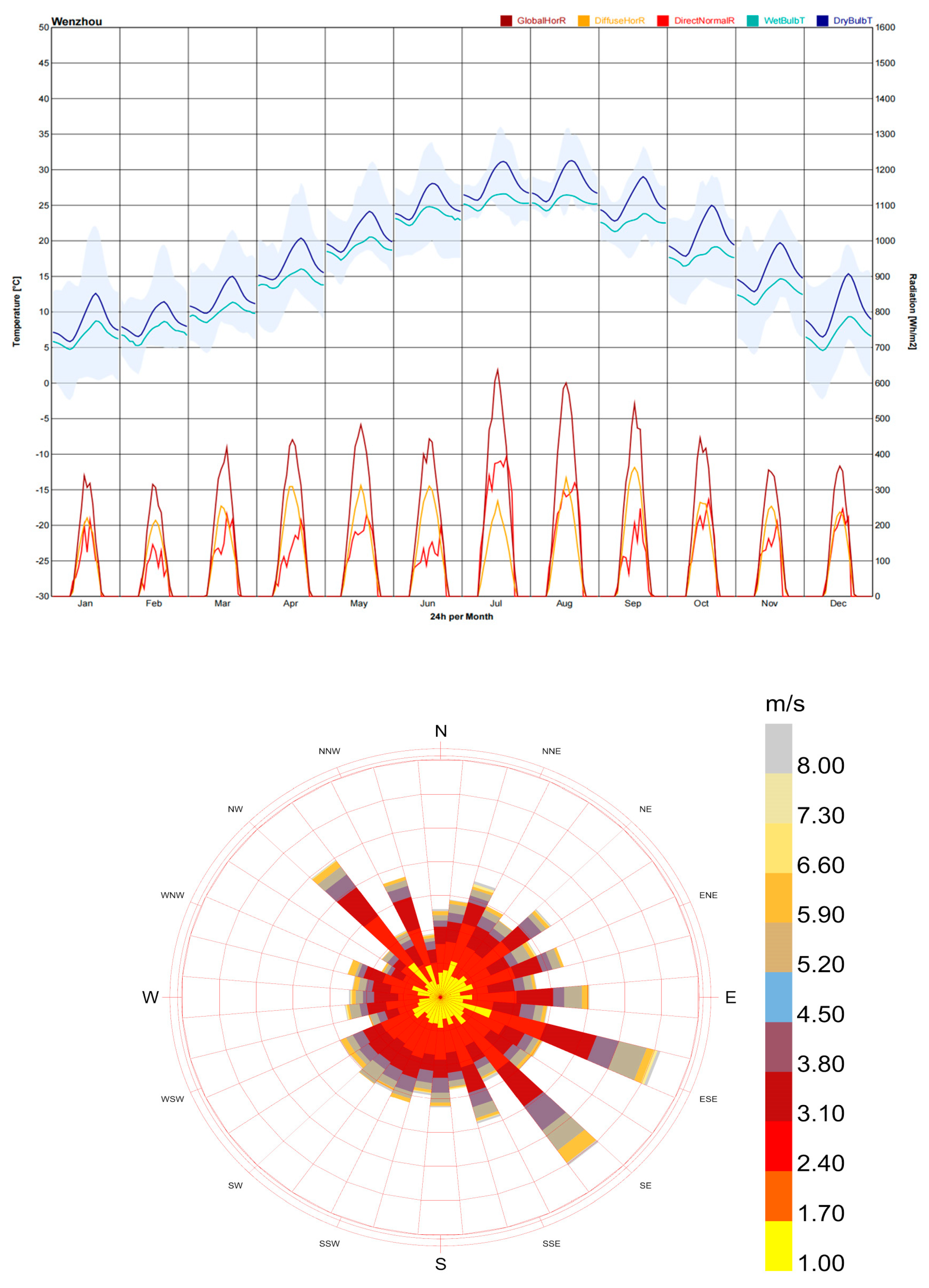
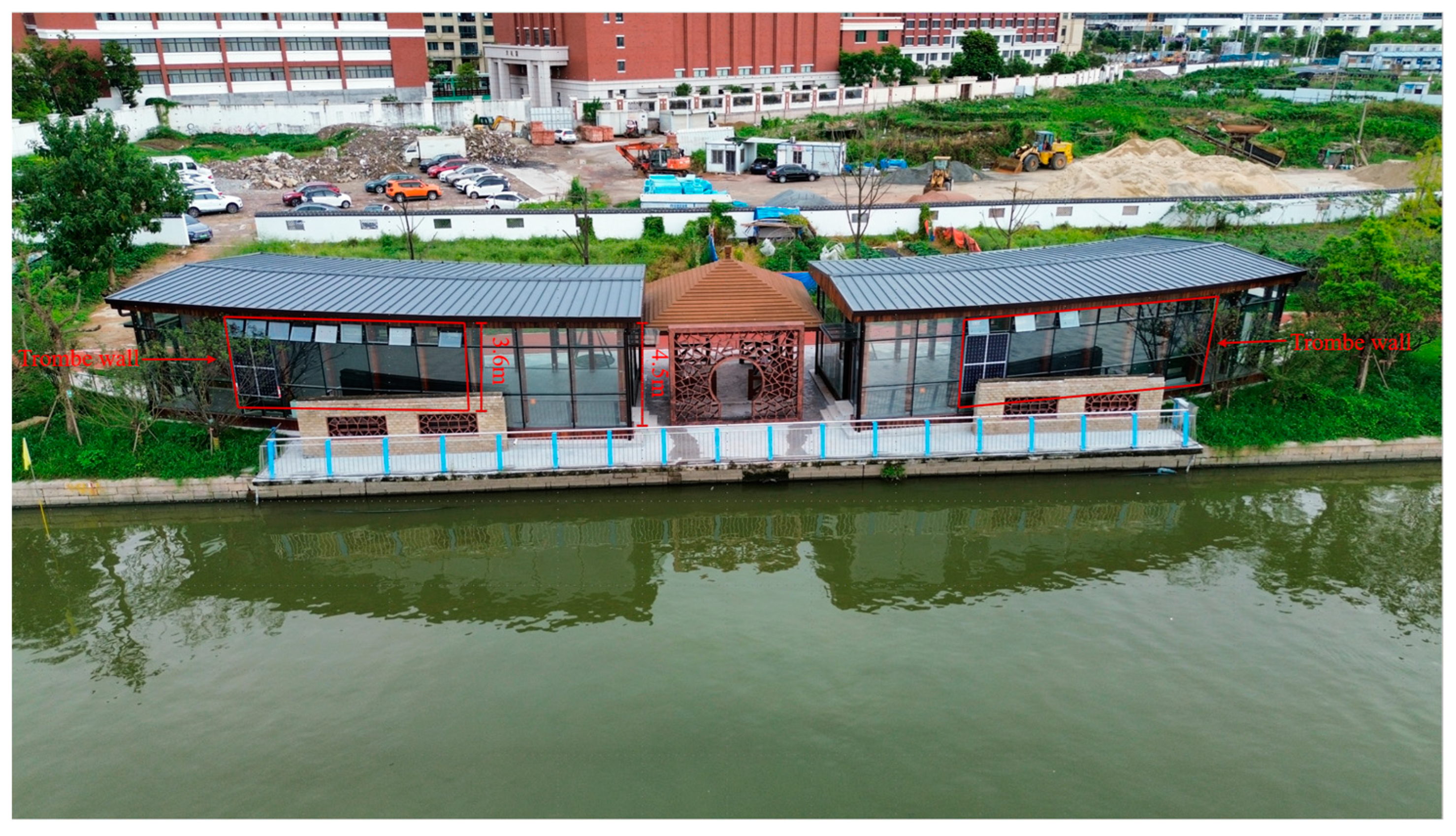

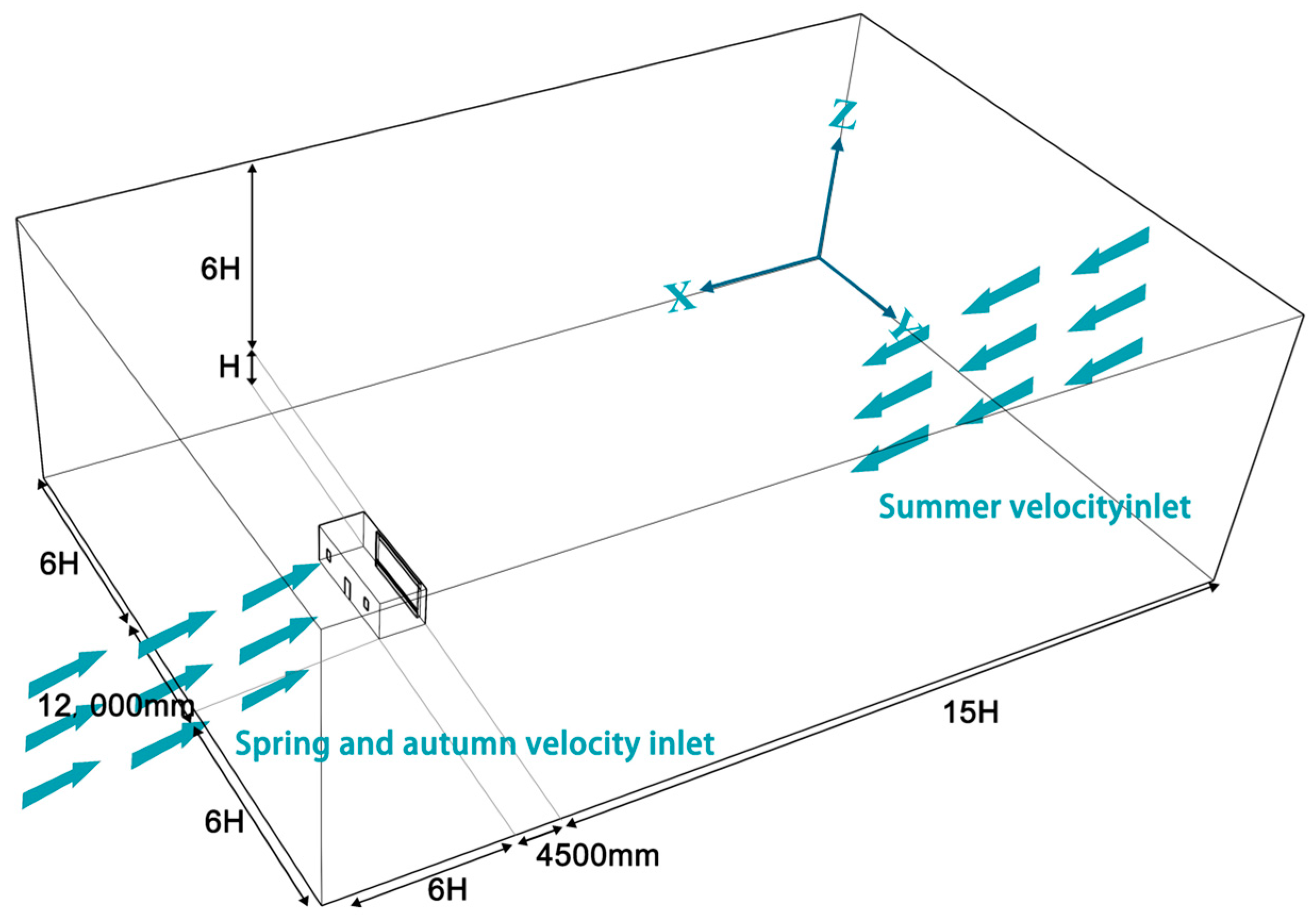


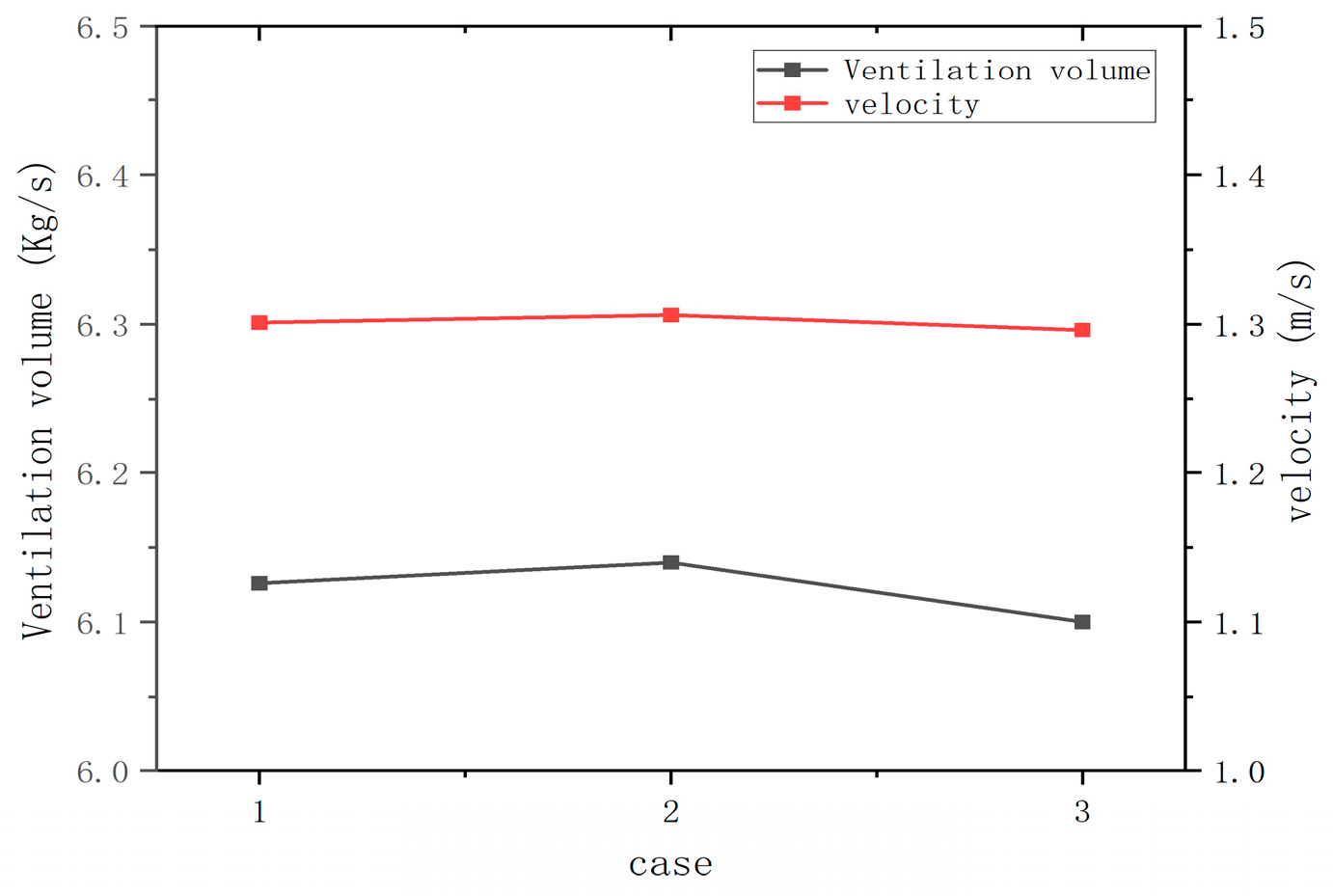

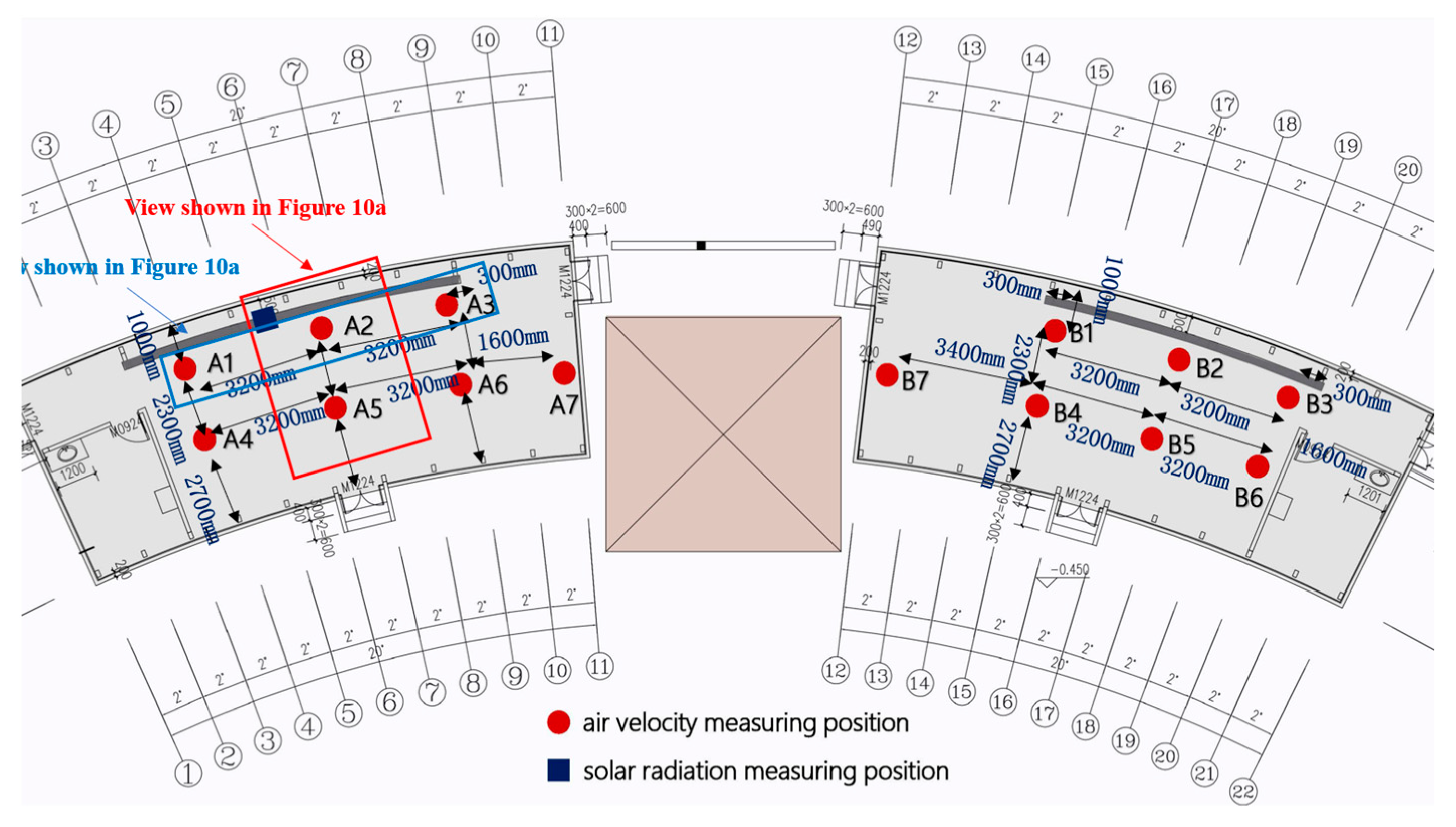

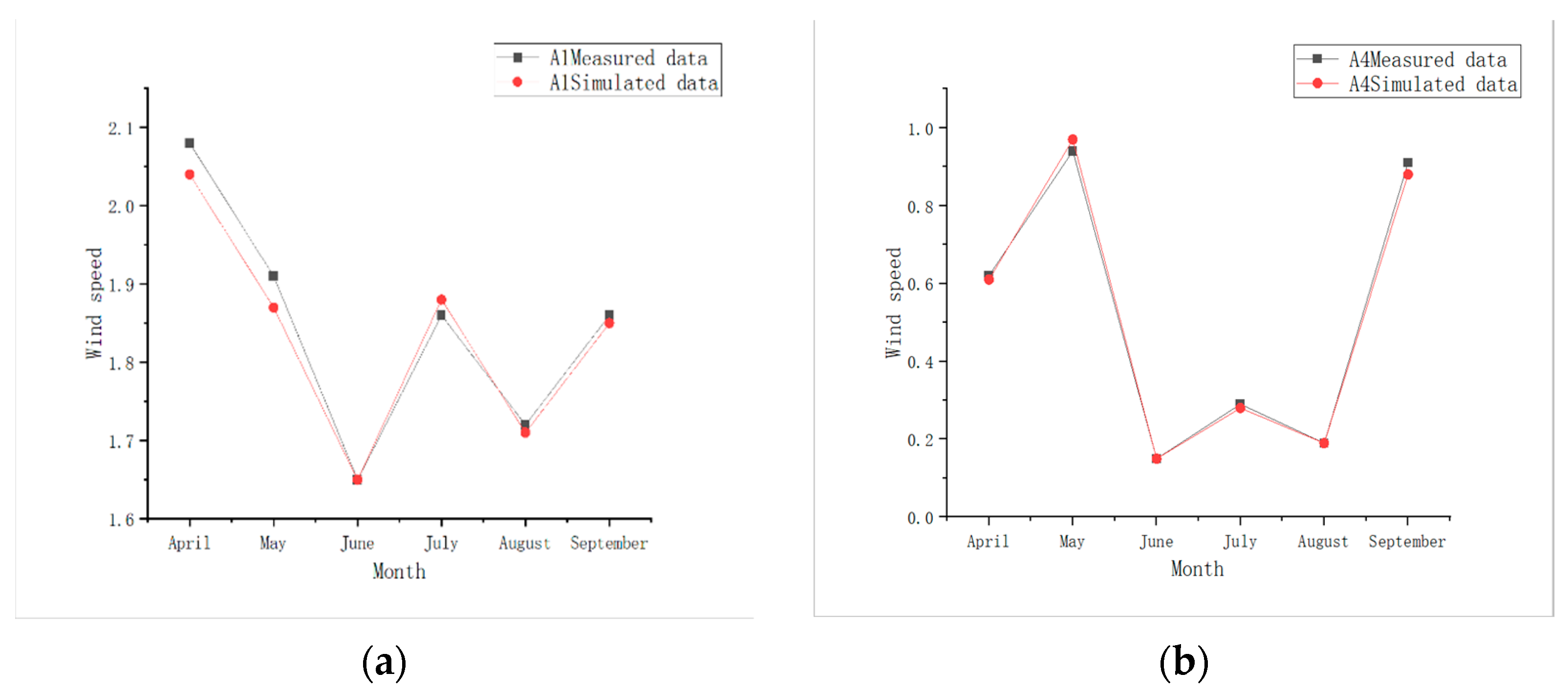
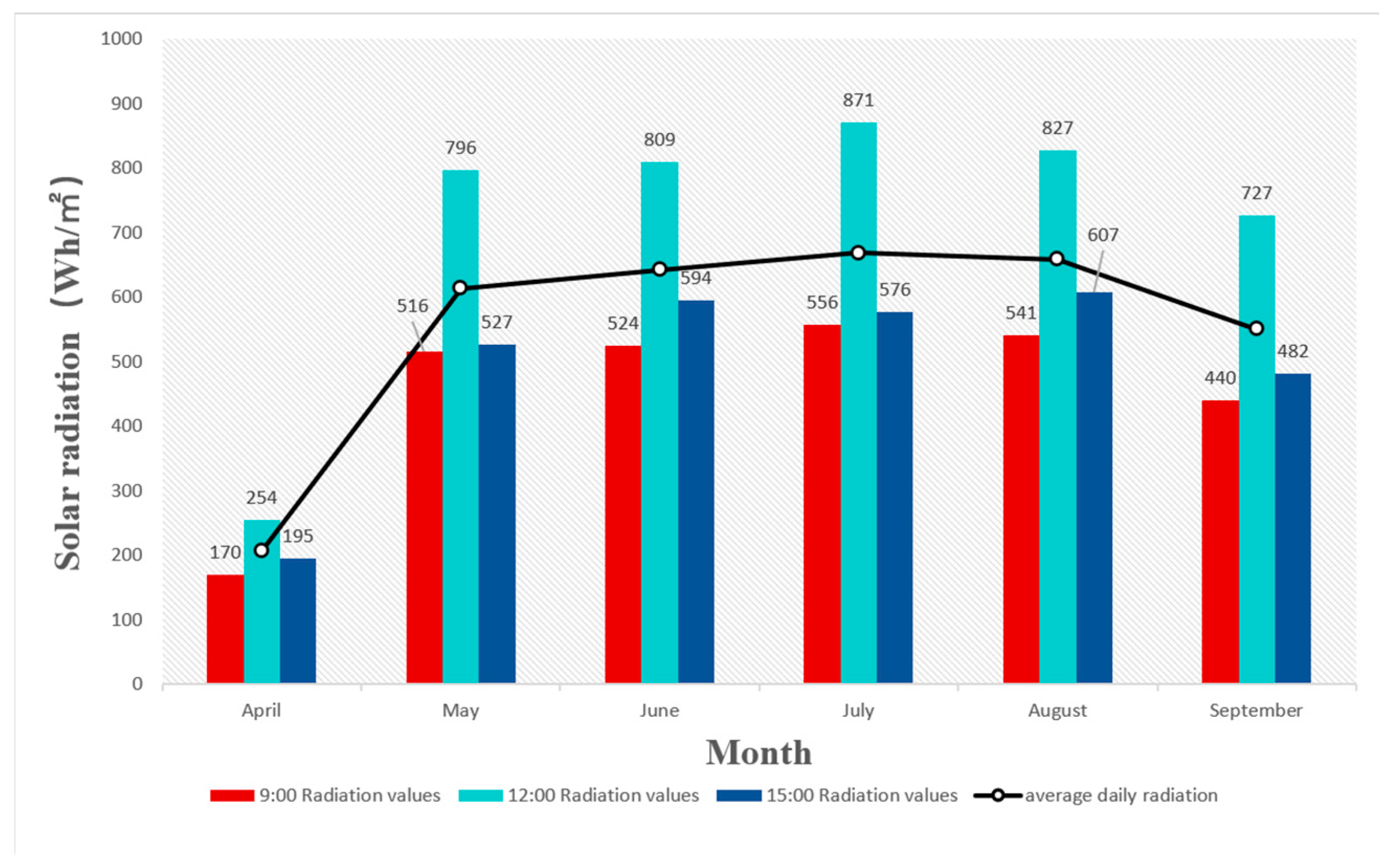
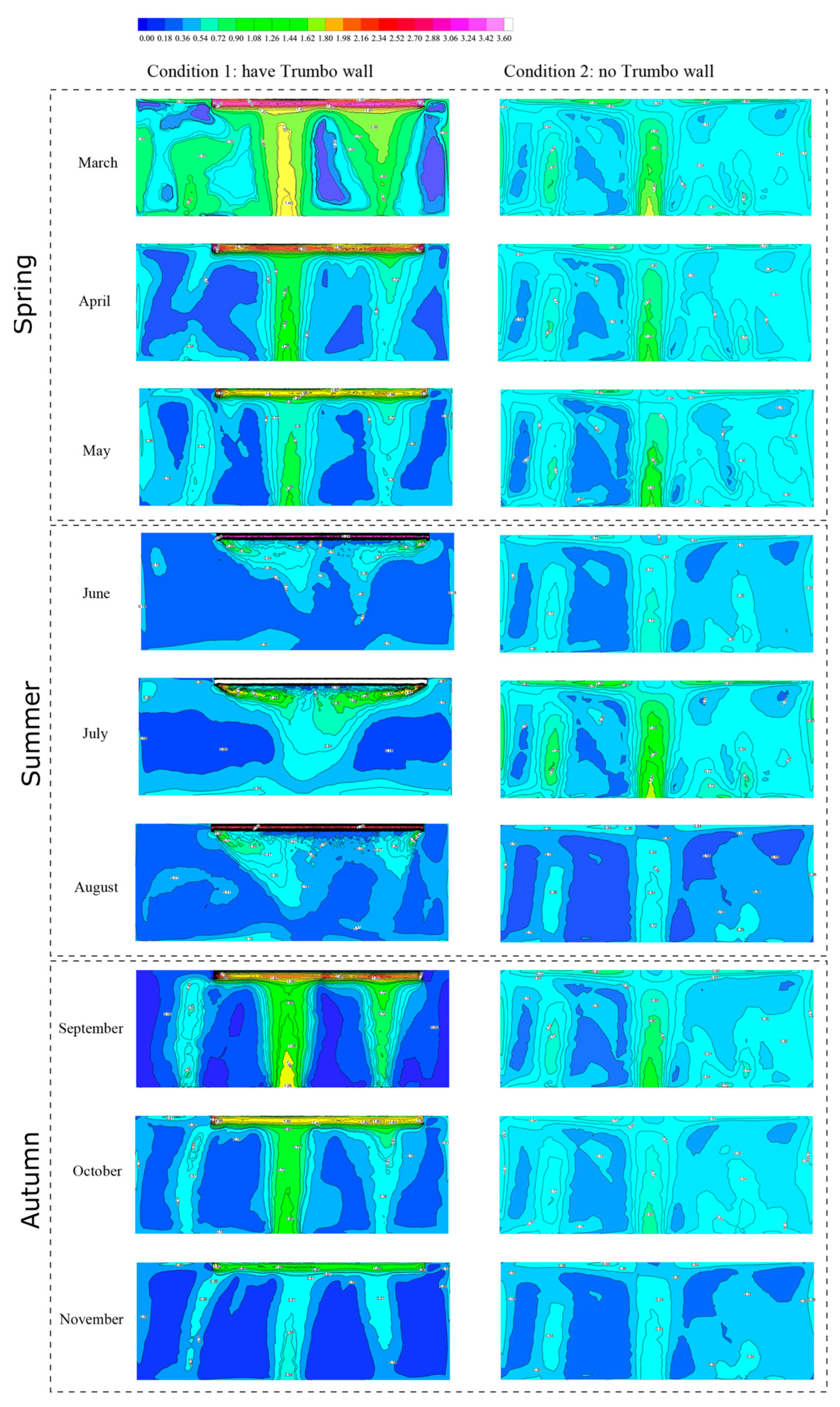
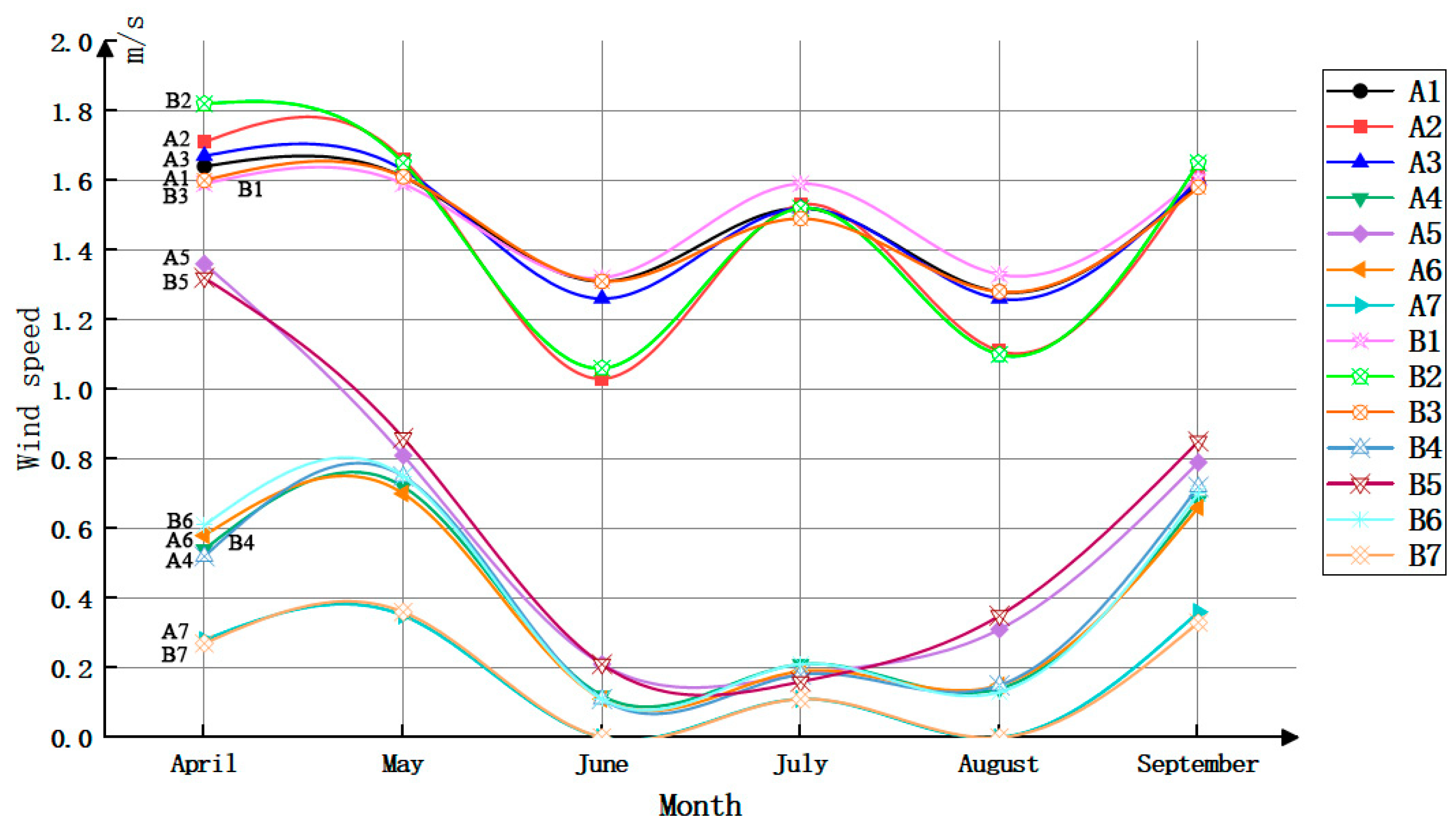


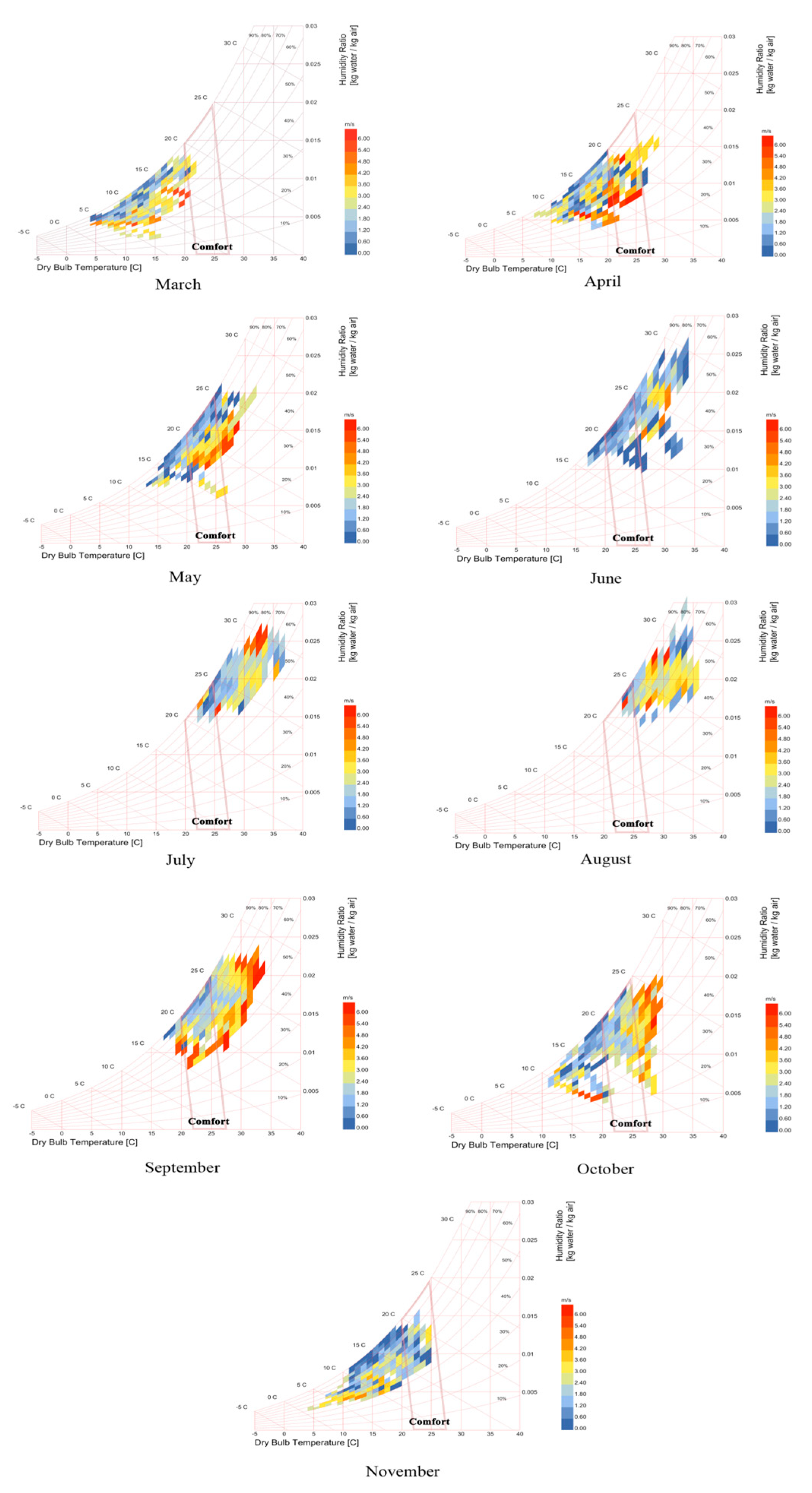

| Name of Material | Densities (kg/m3) | Specific Heat Capacity (J/kg·K) | Thermal Conductivity (W/K·m) | Absorption Rate |
|---|---|---|---|---|
| Heat storage wall | 1440 | 837.4 | 0.43 | 0.95 |
| Fiberglass | 2500 | 1052 | 0.75 | 0.9 |
| Insulated walls | 100 | 2310 | 0.047 | 0 |
| March | April | May | June | July | August | September | October | November | |
|---|---|---|---|---|---|---|---|---|---|
| Average air velocity value | 1.5 m/s | 1.3 m/s | 1.1 m/s | 0.9 m/s | 1.5 m/s | 0.7 m/s | 1.2 m/s | 1 m/s | 0.7 m/s |
| Inlet | N | N | N | S | S | S | N | N | N |
| Instrument Name and Model | Measuring Parameters | Instrument Accuracy and Testing Range |
|---|---|---|
| Heat Index checker 8778 | Wall Temperature, Air Temperature, Air Humidity | Temperature Range: 0–50 °C; Temperature Resolution: 0.1 °C/°F; Temperature Accuracy: ±0.6 °C; Humidity Range: Humidity Resolution: 0.1% RH; Humidity Accuracy: ±3% RH; Black Globe Temperature: 0–50 °C; Black Globe Temperature Accuracy: ±1.5 °C; WBGT Temperature Range: 0–50 °C; Black Globe Dimensions (mm): Diameter: 40, Height: 35. |
| TENMARS UV intensity detector TM-213 | Solar Radiation on the Wall Surface | Peak Wavelength: 365 nm; Measurement Range: 0–3999 μW/cm2/0.01 mW/cm2–39.99 mW/cm2; Accuracy: ±20 μW/cm2 ± (4% + 2 digits). |
| Airflow Anemometer GM8902 | Wind Speed at the 1.5 m Elevation Measurement Point | Wind Speed Measurement Range: 0.1–45 m/s; Resolution: 0.1; Accuracy: ±3%. |
| Measuring Point | Average Wind Speed Value at the Time Point | ||
|---|---|---|---|
| Nine O’clock | Twelve O’clock | Fifteen O’clock | |
| April (A1) | 1.64 | 2.08 | 2.11 |
| April (A2) | 1.71 | 2.23 | 2.36 |
| April (A3) | 1.67 | 2.15 | 2.19 |
| April (A4) | 0.54 | 0.62 | 0.69 |
| April (A5) | 1.36 | 1.47 | 1.72 |
| April (A6) | 0.58 | 0.64 | 0.7 |
| April (A7) | 0.28 | 0.31 | 0.39 |
| April (B1) | 1.59 | 2.13 | 2.15 |
| April (B2) | 1.82 | 2.31 | 2.36 |
| April (B3) | 1.6 | 2.23 | 2.26 |
| April (B4) | 0.52 | 0.63 | 0.64 |
| April (B5) | 1.32 | 1.56 | 1.71 |
| April (B6) | 0.61 | 0.69 | 0.75 |
| April (B7) | 0.27 | 0.31 | 0.35 |
| May (A1) | 1.61 | 1.91 | 1.93 |
| May (A2) | 1.66 | 1.94 | 1.97 |
| May (A3) | 1.63 | 1.91 | 1.92 |
| May (A4) | 0.72 | 0.94 | 0.9 |
| May (A5) | 0.81 | 1.26 | 1.29 |
| May (A6) | 0.7 | 0.91 | 0.89 |
| May (A7) | 0.35 | 0.36 | 0.41 |
| May (B1) | 1.59 | 1.96 | 1.96 |
| May (B2) | 1.65 | 1.98 | 2.05 |
| May (B3) | 1.61 | 1.92 | 1.95 |
| May (B4) | 0.75 | 0.96 | 0.95 |
| May (B5) | 0.86 | 1.32 | 1.29 |
| May (B6) | 0.75 | 0.92 | 0.91 |
| May (B7) | 0.36 | 0.38 | 0.47 |
| June (A1) | 1.31 | 1.65 | 1.57 |
| June (A2) | 1.03 | 1.08 | 1.06 |
| June (A3) | 1.26 | 1.63 | 1.58 |
| June (A4) | 0.12 | 0.15 | 0.13 |
| June (A5) | 0.21 | 0.28 | 0.23 |
| June (A6) | 0.11 | 0.15 | 0.13 |
| June (A7) | 0 | 0.1 | 0.1 |
| June (B1) | 1.32 | 1.68 | 1.57 |
| June (B2) | 1.06 | 1.09 | 1.07 |
| June (B3) | 1.31 | 1.68 | 1.61 |
| June (B4) | 0.11 | 0.13 | 0.11 |
| June (B5) | 0.21 | 0.29 | 0.25 |
| June (B6) | 0.11 | 0.14 | 0.12 |
| June (B7) | 0 | 0 | 0.1 |
| July (A1) | 1.52 | 1.86 | 1.83 |
| July (A2) | 1.53 | 1.76 | 1.78 |
| July (A3) | 1.52 | 1.89 | 1.86 |
| July (A4) | 0.21 | 0.29 | 0.27 |
| July (A5) | 0.18 | 0.21 | 0.23 |
| July (A6) | 0.19 | 0.26 | 0.23 |
| July (A7) | 0.11 | 0.11 | 0.12 |
| July (B1) | 1.59 | 1.74 | 1.82 |
| July (B2) | 1.52 | 1.72 | 1.75 |
| July (B3) | 1.49 | 1.71 | 1.8 |
| July (B4) | 0.18 | 0.21 | 0.21 |
| July (B5) | 0.16 | 0.27 | 0.25 |
| July (B6) | 0.21 | 0.26 | 0.35 |
| July (B7) | 0.11 | 0.11 | 0.11 |
| August (A1) | 1.28 | 1.72 | 1.68 |
| August (A2) | 1.11 | 1.15 | 1.12 |
| August (A3) | 1.26 | 1.75 | 1.71 |
| August (A4) | 0.14 | 0.19 | 0.19 |
| August (A5) | 0.31 | 0.54 | 0.56 |
| August (A6) | 0.15 | 0.18 | 0.2 |
| August (A7) | 0 | 0 | 0.1 |
| August (B1) | 1.33 | 1.75 | 1.71 |
| August (B2) | 1.1 | 1.15 | 1.14 |
| August (B3) | 1.28 | 1.73 | 1.71 |
| August (B4) | 0.15 | 0.18 | 0.18 |
| August (B5) | 0.35 | 0.57 | 0.52 |
| August (B6) | 0.13 | 0.16 | 0.15 |
| August (B7) | 0 | 0 | 0.1 |
| September (A1) | 1.59 | 1.86 | 1.82 |
| September (A2) | 1.62 | 1.95 | 1.91 |
| September (A3) | 1.6 | 1.86 | 1.83 |
| September (A4) | 0.68 | 0.91 | 0.9 |
| September (A5) | 0.79 | 1.28 | 1.26 |
| September (A6) | 0.66 | 0.91 | 0.87 |
| September (A7) | 0.36 | 0.52 | 0.47 |
| September (B1) | 1.61 | 1.91 | 1.87 |
| September (B2) | 1.65 | 2.06 | 2.02 |
| September (B3) | 1.58 | 1.92 | 1.92 |
| September (B4) | 0.72 | 0.98 | 0.97 |
| September (B5) | 0.85 | 1.41 | 1.37 |
| September (B6) | 0.7 | 0.97 | 0.99 |
| September (B7) | 0.33 | 0.57 | 0.52 |
| 9:00 | 12:00 | 15:00 | |
|---|---|---|---|
| April | 17 | 25 | 25 |
| May | 24 | 29 | 31 |
| June | 27 | 35 | 33 |
| July | 29 | 38 | 39 |
| August | 30 | 39 | 39 |
| September | 28 | 35 | 36 |
Disclaimer/Publisher’s Note: The statements, opinions and data contained in all publications are solely those of the individual author(s) and contributor(s) and not of MDPI and/or the editor(s). MDPI and/or the editor(s) disclaim responsibility for any injury to people or property resulting from any ideas, methods, instructions or products referred to in the content. |
© 2024 by the authors. Licensee MDPI, Basel, Switzerland. This article is an open access article distributed under the terms and conditions of the Creative Commons Attribution (CC BY) license (https://creativecommons.org/licenses/by/4.0/).
Share and Cite
Sheng, Z.; Zhang, G.; Luo, X.; Ye, C.; Lin, J.; Chen, Z. Research Optimizing Building Ventilation Performance through the Application of Trombe Walls in Regions with Hot Summers and Cold Winters: A Case Study in China. Sustainability 2024, 16, 3107. https://doi.org/10.3390/su16083107
Sheng Z, Zhang G, Luo X, Ye C, Lin J, Chen Z. Research Optimizing Building Ventilation Performance through the Application of Trombe Walls in Regions with Hot Summers and Cold Winters: A Case Study in China. Sustainability. 2024; 16(8):3107. https://doi.org/10.3390/su16083107
Chicago/Turabian StyleSheng, Zechao, Guoyi Zhang, Xiaojun Luo, Chenle Ye, Jinhe Lin, and Zhonggou Chen. 2024. "Research Optimizing Building Ventilation Performance through the Application of Trombe Walls in Regions with Hot Summers and Cold Winters: A Case Study in China" Sustainability 16, no. 8: 3107. https://doi.org/10.3390/su16083107





